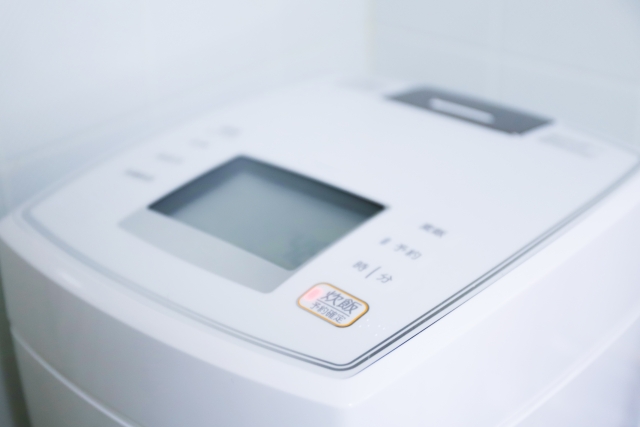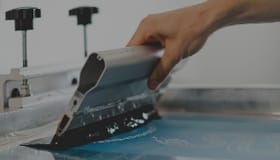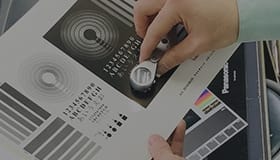Product overview
EGR inks show good adhesion to various polyester films. Slow-drying ink suitable for fine printing. It is a printing ink with excellent post-processing properties, especially for nameplates.
- Solvent type ink

Application
- Nameplates, membrane switches, PET stickers
-
Automobile, Motorcycle
-
Home Appliance (IoT)
-
Smartphone, Tablet, Smart watch
-
Sensor
-
Game
-
Others
Features, Function
- Semi-gloss finish ink layer with excellent embossing resistance and lightfastness
- Use of catalyst can improve ink layer resistance
- Multi color setting
Substrate
- Various PET films or PER stickers
- PC
- PC
- PET
Dilution
- G-001 SOLVENT(fast) G-002(standard) G-003(slow) G-004(extra slow)
- DILUTION 5-20%
Catalyst, Promoter mixing
- Not necessary
- *For enhanced adhesion, a catalyst can be used in combination. In this case, please use the following
- *The ink will turn to gel after the pot life has expired. Be sure to mix only enough to use
96 CATALYST 3-5%(Priority: Resistance and adhesion) Pot life 4-5 hrs.
101 CATALYST 7%(When weather resistance is not required)Pot life 2-3 hrs.
Promoter
- Leveling agent 0-2% (to improve leveling)
- SM-40 Defoamer 0-2%(For defoaming requiring transparency)
Recommended cleaner
- Screen Cleaner L2 or G-002 Solvent
Mesh
- T-200 to 270 mesh (Coverage would be 35-50m2/kg at 250 mesh)
Drying
- 60℃ 40 min or 80℃ 30 min
*Ensure sufficient drying - Overprint
Each layer 60℃ 10 min (tack free)
Final layer 60℃ 40 min or 80℃ 30 min
Standard colors
-
000 MEDIUM
-
001 VICTORIA
-
003 BRIGHT RED
-
121 SCARLET
-
161 SCARLET
-
177 OPAQUE RED
-
182 RED
-
221 YELLOW
-
231 YELLOW
-
263 REDDISH YELLOW
-
271 OPAQUE LIGHT YELLOW
-
277 OPAQUE REDDISH YELLOW
-
391 BLUE
-
525 ORANGE
-
577 OPAQUE ORANGE
-
581 MAGENTA
-
611 WHITE
-
621 WHITE
-
671 OPAQUE WHITE
-
675 OPAQUE WHITE
-
797 GREEN
-
821 VIOLET
-
911 BLACK
-
971 BLACK
Caution
- Checking before commercialization: Adhesion and resistance properties may change due to differences in substrates, processes, printing and drying conditions. Be sure to check the adhesiveness and resistance properties before mass production printing
- Ink shelf life: 24 months from production date, unopened.
Safety
- UN No.: Not classified in the definition
- UN Classification: Not classified in the definition
Handling
- Use safety gloves and eyeglasses to protect skin and eyes. If the ink comes in contact with skin, wash with soap and plenty of water(or lukewarm water) and consult with a doctor.
- Containers should be closed tightly after use and stored in a cool and dark place.
- SDS is available upon request. Please request a copy and read it carefully before handling the products.
Resistance
| Test items | Test conditions | Test results |
|---|---|---|
| Adhesion | JIS K 5600-5-6:ISO2409(Cross-cut), 1mm interval 6x6 cuts、Cellophane tape and peel | 0(No peel off) |
| Scratch hardness | JIS K 5600-5-4:ISO 15184(Pencil method)、750g weight, hardness of the pencil which does not make scar | H |
| Heat | JIS K 5600-6-3:ISO 3248, 150℃, 100H, check appearance and peeling off from the substrate | No defect |
| Hot water | JIS K 5600-6-2:ISO 2812-2, 60℃ warm water、Soak 48 hrs., check appearance and peeling off from the substrate | No defect |
| Humidity and cool-heat cycling test | JIS K 5600-7-4 10 cycles, 50℃, 95%RH(13H) ~-20℃(3H)~-25℃(30H)~ 20℃(0.5H) check appearance and peeling off from the substrate | No defect |
| Acid | 7hrs. in 5% H2SO4, check appearance of ink layer and peeling off from the substrate | No defect |
| Alkaline | 7 hrs. in 5% NaOH, check appearance and peeling off from the substrate | No defect |
| Alcohol | Gakushin scrub tester, cotton soaked ethanol, 200g weight, 50 back and forth. Check peeling off | No defect |
| Scrub | Gakusin scrub tester, with cotton, 1000g weight, 200 back and forth, check color fade | No defect |
| Bend test | JIS K 5600-5-1: ISO 1519 (Cylindrical Mandrel) 2mm dia. Check crack | No defect |
| Falling-weight test | JIS K 5600-5-3 DuPont Impulse tester, drop 1kg from 50cm height | No defect |
| Embossing | JIS K 5400 8.2 (Erichsen Tester), Push-in distance at which crack appears in printed layer | 7 mm |
| Punching | Punching by press machine | No defect |
| Accelerated weathering (Carbon-arc) | JIS K5400 9.8.1 Weather meter with carbon arc, BP temp. 63+/-3℃:Rain rate 18 min/120 min、check color fade and peeling off | No defect |
Test Condition
- Test conditions 【EGR-911 BLACK】 【G-002 Solvent 20%】 【80℃ 30min】 【T-250】 【Substrate:125µm PET】
- Above resistance test results are measured results in our laboratory and they are not guaranteed values.
- Information contained in this catalog may change without prior notice.
FAQ
-
What is screen printing?
-
Screen printing is a type of stencil printing which uses a technique of duplicating the image from a design made on mesh stencils.
When printing ink goes through the mesh, it transfers the image onto the substrate material. Other than air and water, any substrate materials are printable. Not only flat surfaces, but also curved, specially shaped, and molded products are suitable for screen printing.
-
When over-printed with a black ink, we often have pinholes. How can we eliminate the pinholes?
-
See the list below for causes of pinholes:
1. The first layer is too thin (less than 5 µ)
2. Too much dilution of the ink (more than 20%)
3. Too much squeegee pressure
4. Under layer is pale colored, such as a medium based color
5. Any combination of these causes -
What are the standard drying conditions?
-
In multi-color printing, primary drying would be done after each color is printed. After the final color is printed, the final drying should be done according to the conditions listed in the catalog. If the color printed ink is a “two-pot” ink the final drying should be done after the printing of the Binder.
-
Why there is “Primary” drying and “Final” drying?
-
Residual solvent at the time of injection may cause ink flow and insufficient adhesion. To prevent these malfunctions, residual solvent must be evaporated through a “Final” drying process.
-
When we extended the primary drying time, pinholes and cracks resulted. How can we eliminate them?
-
With one-pot inks, if the primary drying time is too long, the solvent of second ink penetrates the first color layer and makes pinholes.
With two-pot inks, if the primary drying time is too long, a curing process occurs. Thus when the second color is printed, the first color ink layer wrinkles and looks like cracks. The countermeasure in either case would be to shorten the primary drying time.
- Related technical information
- Related inks

